Agroha
1.INTRODUCTION ABOUT AGROHA & MAHARAJA AGRASEN
Agroha (Agra or Agr) Republic was established around 51 years before the war of Mahabharata. According to the writers of "Bhavishya Puran; Ke Agravansh" "Vanishanukirtnam" and "Uru Charitam" Maharaja Agrasen ruled about 5000 years back over Agroha around the time of Mahabharata.

HISTORICAL BACKGROUND.
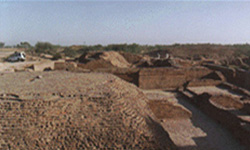
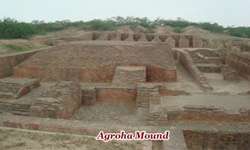

"In order to live in heaven after death, we shall have to live in heaven before death" avowed Maharaja Agrasen, a king of great administrative skill. His concepts of kingdom and the duties of the king towards his subjects evolved him as a centurial man. Equality, Nationalism, Socialism and Non-Violence were the principles which formed the backbone of his kingship.
2.HISTORY & PRINCIPLES OF MAHARAJA AGRASEN
Maharaja Agrasen was born as the eldest son to the Suryavanshi King Ballabh of Pratapnagar, about 5185 years ago, during the Dwapar Yug. Maharaja Agrasen was a Kshatriya and a Suryavanshi (lineage from the Sun, King Yayati of Khandav prastha) and was the elder brother of Shursen Vrishni and elder grandfather of Shri Balrama and Shri Krishna Vrishni born during the last stages of the Dwapar Yuga.
The young prince Agrasen was an icon of non-violence, messenger of peace and well known for his compassion. He never discriminated against anyone and his subjects were happy and contented.
Hindu mythology says that the King of the Devas, Indra wanted to marry Queen Madhavi, the wife of Agrasen and waged a long war. Eventually Narada negotiated peace between them. Agrasen was moved by the suffering of his subjects during the war.
Maharaja Agrasen started a severe penance to propitiate Lord Shiva, in the city of Kashi. Pleased with the penance of Maharaja Agrasen, Lord Shiva appeared and advised him to propitiate Maa Mahalaxmi. Maharaja Agrasen again started meditating for the blessings of Maa Mahalaxmi, who appeared before him. Goddess Mahalakshmi then blessed Maharaja Agrasen and suggested that he give up his Kshatriya tradition and take up the Vaishya tradition of business for the sake of prosperity of his people. She then asked him to found a new kingdom and promised that she would bless his descendants with prosperity. So he gave up his Kshatriya tradition.
With the blessings of Maa Mahalaxmi, Maharaja Agrasen started out with the Queen to travel all over India and select a place for a new kingdom. During his travels, at one place he found a few tiger cubs and wolf cubs playing together. To Maharaja Agrasen and Queen Madhavi, this was an auspicious indication that the area was Veerabhoomi (land of the brave) and they decided to found their new kingdom at that location named it as AGROHA or Agreya near Hissar. Agroha was called as Agreya in its original period. King Agrasen made it the capital of his state, a city in ancient Kuru Panchala. Agroha became prosperous as agriculture and trade flourished.
Due to continuous attacks made by Jarasandh, Great King of Magadh, who was father in law of Kansa, the famous King of Mathura, against Shri Balram, Shri Krishna and their relatives. At the time Maharaja Agrasen established and ruled Agreya, Maharaja Shursen and Shri Krishna and Shri Balram migrated to Dwarka in Gujarat.
Archaeological evidences tell us that Agroha town was established earlier than 3rd century BC. Kushan and Yaudheya coins, bricks with designs of human heads with typical hair styles, terracotta seals and sculptures are among the finds discovered. Ancient structures, pot-shards, coins and seals have been found in archaeological excavations.
PRINCIPLES OF MAHARAJA AGRASEN:
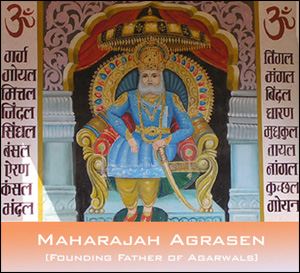
Simple and practical principles were laid down for the equality, love & affection among people of the domain. He was the first ruler who established socialism in his regime.
According to legend, Agroha was a prosperous city and a hundred thousand traders lived in the city during its heyday. An insolvent community man as well as an immigrant wishing to settle in the city would be given “One Rupee & One Brick” by each inhabitant of the city. Thus, he would have a hundred thousand bricks to build a house for himself, and a hundred thousand rupees to start a new business. Therefore, no one was unemployed in his regime and everyone was having their own homes. There could be no other better practical principle of socialism of humanity than this. These principles became practical in his kingdom, as give and take was the formula in the life of every ordinary resident. Neither the receiver felt shamed nor the donator felt proud.
Feelings of social welfare and brotherhood were the fundamentals of the principle. There was no place for corruption or selfishness in the kingdom. The development of the kingdom and life of people were completely based on agriculture, trade & dairy.
His belief in non-violence did not mean non-resistance to oppression, rather he promoted self defense. According to him, self protection and national defense were not the task of only kshatriyas - the warrior caste, rather it was the duty of each citizen to protect and safeguard their motherland.
Maharaja Agrasen established Agroha as a republican state. Maharaja Agrasen proceeded to conduct 18 Maha Yagnas. He divided his kingdom among his 18 children in 18 state units and established the 18 Gotras after the Guru's of each of his children. These same 18 Gotras are like the eighteen chapters of the Bhagavad-Gita; although they differ, they are still related to each other to form the whole.
During the course of the 18th Yagna, he adopted the ideal of non-violence wherein he realised the futility of animal sacrifices. The Yagna was being performed for the establishment of the 18th Gotra. He proclaimed "Instead of targeting a crane with an arrow, I wish to see it flying; Instead of eating away a nightingale, I wish to hear it singing". And with this proclamation he banned all animal sacrifices. Thus, the eighteenth yajna was never completed and Maharaja Agrasena had only completed only seventeen and a half yagnas. According the sage Garga blessed him with seventeen and a half gotras.
Accordingly Agroha was broken up in 18 state units as per the Gotra. All the residents of that particular state unit became identified by that Gotra. It was maintained by Maharaja Agrasen that a nuptial alliance could not take place in the same Gotra and restricted people of the same Gotra from inter-marrying, a custom which prevails even today. This rule enunciated by Maharaja Agrasen promoted harmony and brotherhood among all the 18 Gotra represented by state units. This facilitated promotion of unity and nationalism among the state units.
As the years rolled by, the subjects, known as Aggarwals, of the Kingdom dispersed into various areas far and wide, carrying their identity of their Gotra with them and spread out all over Bharat. Today, these people are known as Aggarwals, Guptas or Banias. Banias are mostly Vaishnavite Hindus. The majority are devout Sanatan Dharmis, but some are also members the Arya Samaj, Dev Samaj, Radhaswami, Namdhari and Nirankari sects of Sikhism.
The 18 Gotras instituted by Maharaja Agrasen were as follows:
Aren |
Bansal |
Bhandal |
Bindal |
Dharan |
Garg |
Goel |
Goen |
Jindal |
Kansal |
Kuchhal |
Mangal |
Mittal |
Mridkul |
Nagal |
Singhal |
Tayal |
Tingal |
The residents of these 18 states were known as Yodhya and Agraya. Some of the writings on the coins that have been excavated from the site of ancient Agroha read as 'Yodhyanam Bahu Dhanya Kanam','Yodhya Ganasya Jaya', 'Yodhyanam Jaimantra Shalinam'.
3.HISTORY OF AGROHA
The Agroha Mound or `Ther` is situated about 1.5 km away from the present Agroha village. Buried under this mound are the remains of the ancient town. Agroha is situated in the district of Hissar, Haryana and in it lies buried the ruins of the capital of the Agroha State. The ancient Agroha town existed some hundred years before the Kushan dynasty.
According to the Punjab Govt. Gazette "Agroha" was a very big ancient city. The primary efforts to discover its historical past were made in the year 1888-89, when the Indian Govt. started excavations at the ancient Agroha site under archaeologist C.T. Rogers. However the initial excavations were carried out only for 15 Days.
The excavation was restarted in the year 1938-39, though even this could not be carried on for long due to the 2nd World War, but it provided major historical input towards Agroha's existence. In 1978-79 the Archaeological Department of Haryana Govt. began excavation work under the guidance and supervision of Mr. J.S.Khatri and Mr. Acharya. It was at this time that people actually became aware of the extent of this great kingdom.
Ancient Sites: Two sites from the pre-Harappan and Harappan period can be found in Rakhi Garhi, Jind and Agroha Mound. Some of the materials collected from the excavated site at Agroha:
Coins: A large number of coins have been found at the excavated site. The coins are predominantly of silver & bronze in different shapes and sizes. The Script and signs on the coins depict that they belong to different periods. The bronze coins have "Agadke, Agach, Janpads" in Prakrit language inscribed on them. A coin dated 200 BC called die struck or counter struck has been found besides Roman, Kushana, Yodhaya and Gupta dynasty coins.
Seals: The seals that have been found at Agroha have been inscribed with words like "Pitradutt", "Sadhu Vridhasya", "Shamkar Malasya", "Madrsya" etc.
Artifacts: From the excavation site many statutes made of stone and sand have been unearthed. Masks, Terracotta Animals and Toys have also been found. Utensils belonging to 2nd century BC in black, brown and red polish have also been discovered. It became quite apparent from the excavations that below the mounds exists a big, well planned progressive town. It was the place where Harappan coins were discovered apart from stone sculptures, terracotta seals, iron and copper implements, shells etc.
It was in these lands that the very first evidence of the presence of man was discovered with the excavation of Agroha, Banawali and Kunal. All of these were the pre-Harappan settlements, bringing for us the very first images of prehistoric times. The presence of the pillar in the Hissar Fort belonging to the time of Emperor Ashoka (234 BC) was originally from Agroha. The discovery of coins of the Kushan Kings tells tales of ancient India.
The Agroha Mound consists of the Agroha Dham on one side and the Sheela Mata Shakti Mandir on the other side
PRE-HARAPPAN HISTORY OF INDIA
Vedic civilization is the earliest civilization in Indian history of which we have written records that we understand. It is named after the Vedas, the early literature of the Hindu people. The Vedic Civilization flourished along the River Saraswati, in a region that now consists of the modern Indian states of Haryana and Punjab. The Vedic texts have astronomical dates, that some have claimed, go back to the 5th millennium BC. The use of Vedic Sanskrit continued up to the 6th century BC. Vedic is synonymous with Aryans and Hinduism, which is another name for religious and spiritual thought that has evolved from the Vedas.
The early Aryans: Unfortunately, the origin of the Saraswati Valley civilization (Vedic culture) and its relation to the Indus Valley civilization remain hazy. The timeline of Vedic civilization is 4500 BC-1800 BC while that of Indus valley civilization is 3300 BC-1800 BC. The texts describe a geography that some believe to be North India. The greatest river of the Rigveda was Saraswati, now dry and identified with Ghaggar, a seasonal river. It is believed that this river ceased to reach the Arabian Sea by about 1900 BC. Now, a dry river bed, that seems to fit the description of the Saraswati River, has been detected by satellite imagery. It begins in the modern Indian state of Uttaranchal and passing through Haryana, Punjab, and Rajasthan, reaches the Arabian Sea in Gujarat. Our knowledge of the early Aryans comes from the Rigveda, the earliest of theVedas.
Origins of Hinduism - Hinduism is eternal with no beginning and no end. Current thinking suggests that Hinduism was formed somewhere between 3200-2500 BCE. The date of approximately 3102 BC comes from the Mahabharata epic, where the exact positions of the stars were recorded at Shri Krishna's birth. The later dates come from linguistic and literary dating of the Rig Veda, the oldest of the Hindu spiritual texts.
The origin of Hinduism cannot be ascribed to a single founder, a single time and a single place of foundation. The Vedas (regarded as the earliest piece of written Hindu work) are the spiritual laws binding upon all of creation and even upon God. Each Veda was written by multiple enlightened beings (Hindus) over a period of time. The term "Hinduism" is derived from of the word Sindhu, which literally means "dweller in the Sindhu (Indus) Valley". Hinduism is more of a federation of loosely banded conventional religions and cultures. It is non-organizational and does not seek or encourage collectivism.
What can be said to be common to all Hindus is belief in Dharma, Karma, and Moksha (liberation) of every soul through a variety of moral, action-based, and meditative yogas. Still more fundamental principles include ahimsa (non-violence), the guru/chela dynamic, the Divine Word of OM and the power of mantras, love of Truth in many manifestations, and an understanding that the essential spark of the Divine (Atman/Brahman) is in every human and living being, thus allowing for many spiritual paths leading to the One Unitary Truth.
4.HISTORY & PROFESSION OF THE AGRAWAL COMMUNITY
In those ancient times, Agrayan was one of the numerous states or janapadas. The Mahabharata and the Buddhist and the Jain literature are the chief sources of information about them. The state comprised Fatehpur, Sikar, Jhunjhunu, Nawalgarh, portions of Rajasthan in the west, Mahendranagar and the Hissar districts of Haryana in the south, some areas of Punjab in the north and the territory as far as Agra in the east. Agroha, which is now in ruins and forms part of the Hissar district of Haryana, was its capital.
Maharaja Agrasen is said to have lived up to the age of 193 and ruled for more than a hundred years. He reigned supreme and compassionate till he left his kingdom to attain moksha. In the latter part of his life he nominated his eldest son Vibhu to the throne and took up the Vanaprasth Ashram.
The Agroha republic was renowned for its bravery and prosperity. However over the time it could not stand the foreign invasions of Huns, Greeks and Yavanas, who invaded the north India disintegrating various kingdoms in Punjab. The neighboring kings were envious of Agroha because of its prosperity, thus they frequently attacked it. Because of these aggressions, Agroha faced numerous plights. In due course, the strength of Agroha was sapped. Agroha was devastated during Shahabuddin Ghori’s invasion in 1194. A huge fire engulfed the city causing the citizens to flee. The disintegrated Agroha led to the migration of the residents of Agroha to other parts of the country viz Rajasthan, Uttar Pradesh, Punjab and Malwa, however they derived a common name Aggarwals i.e. AGROHA-WALE.
The surname Agrawal was derived by taking 'Agra' from Agrasena and 'wal' ('wal' originally being 'bal' was taken from the word Baalak meaning child). The word Agrawal effectively means ‘Son of Agrasena’. Many Agrawals have adopted their Gotra name as their surname. However ‘Agarwal’ and ‘Gupta’ are more common surnames adopted by several Agarwal families. As per Maharaja Agrasen's guidance, the Aggarwals are in the forefront of social service.
The Agrawals, who belong to the large Vaishya community, are found in almost every part of the country. They are also known as “Banias” because of their occupation. The term “Vaishya” is very comprehensive and covers several business communities such as Agrawal, Maheshwari, Khandelwal, Oswal, Jaiswal, Poswal, Dasse and Mahajan. Of these, the Agrawal is by far the largest community.
By and large, being businessmen and traders, the Agrawals enjoy a fair share of representation in several other professions as well. If the community has produced numerous renowned businessmen and industrialists like the Dalmias, Modis, Singhanias, Mittals and Bajajs, it has also produced a number of distinguished jurists, educationists, scientists, engineers, politicians, doctors, philosophers, poets and scholars.
5. PRESENT DAY AGROHA AGROHA EK TIRTH
The redevelopment process at Agroha after the excavation was slow. Shri Bholaram Dalmia of Bhiwani District and Shri Sanwalram built a Gau Shala in 1914 at Agroha. Then in 1939 Shri Ramji Das Bojoria from Calcutta had a Shiv Mandir and a rest house built here. All these activities were at a more individualistic level.
It was only in 1976 that a need for a concerted group effort was felt at the convention of Akhil Bartiya Agarwal Sammelan. This realisation led to the establishment of AGROHA VIKAS TRUST in 1976, under Shri Sri Krishna Modi and Shri Rameshwar Das Gupta. Their efforts were supplemented by Late Master Laxmi Narain Aggarwal who donated the 27 acres of land purchased by Shri Tilakraj Agarwal, Shri Devki Nandan Gupta & the office bearer of Maharaja Agrasen Engineering & Technical Society to Agroha Vikas Trust for the development of Agroha Dham.
Late Seth Shri Tilakraj Agarwal was instrumental in building a Dharamshala of 22 rooms to enable people to come and stay at Agroha. Thereafter the development took place in form of a Shakti Sarovar for the collection of water for construction purpose and also thereafter a Temple Complex was planned paying homage to Maharaja Agrasen, Ma Mahalaxmi and Ma Saraswati. The development work at Agroha was entrusted to be carried on under the able supervision of Late Seth Shri Tilakraj Agarwal - Bombay.
Since then all the development process at AGROHA is planned and implemented by Agroha Vikas Trust and the entire area came to be known as AGROHA DHAM . The developments at Agroha received a major boost from 1985 when Shri Subhash Goel joined in as the President of Agroha Vikas Trust. The work at Agroha Vikas Trust was funded by the Agarwals from all-over India. The Agroha Dham construction was re-planned with special emphasis on the Temple Complex and the Shakti Sarovar on which Samudra Manthan scene has been sculpted with arrangement of colored fountains around it. Functionally Agroha Dham has been planned as a center of learning, philosophy and spirituality. It will also have a Vridh Ashram (Old Age Home), Health Center and a Research Center.
The total area under the trust for the development of Agroha Dham is 27 acres. The developments have taken place in the form of a Temple complex dedicated to goddess Mahalaxmi and Saraswati; this also hosts the memorial temple of Maharaja Agrasen. The beauty of the place is exemplified by the Shakti Sarovar and the well maintained lawns.



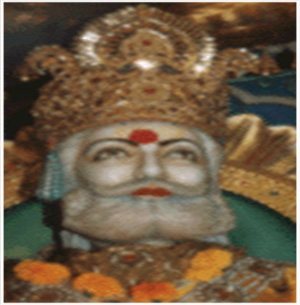
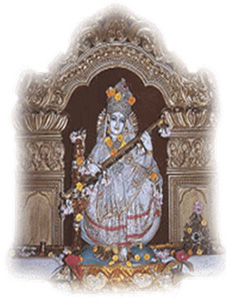
Opposite the Trust compound is the Maharaja Agrasen Medical College and Research Centre. The medical college is one of the most prestigious education centres for medical studies. It is gearing up to become one of the biggest medical research centres under the supervision of Shri O. P. Jindal. This facility is spreads over a area of 267 Acres of land and the Government of Haryana has give 100% Tax Exemption for all donations received by this Medical College and Research Centre. Further the Government of Haryana is contributing 50% of the total cost of the Project. The balance 50% is being funded by Aggarwals all over India and the world. Late Seth Shri Tilakraj Agarwal became one of the 1st Donors for this project.

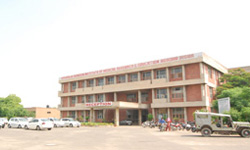
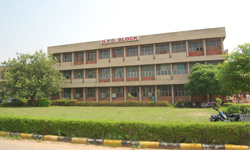
About 1 Km away from the temple complex of Agroha Dham there was a Madhi (Ancient Temple) of Sheela Mata. Here the local public and Agarwal families from all over India visit for the Mundan (Head Shaving) of their children and for seeking the blessings of the deity. Late Seth Shri Tilakraj Agarwal
decided to develop this old Madhi of Sheela Mata into a big temple as his personal contribution to the development of Agroha and started the work of Sheela Mata Shakti Mandir in the year 1982.He established 'Agroha Vikas Sansthan' for this purpose and started the work of this temple with great enthusiasm.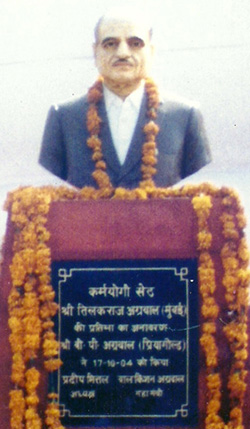
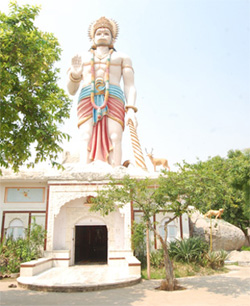
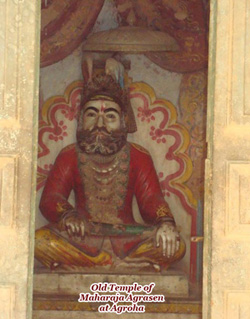
Another project initiated in Agroha was the Agra Vibhuti Samarak under the name of Shri Agrasen Foundation spread over an area of 10 acres of land purchased by Akhil Bhartiya Aggarwal Samellan for this purpose. The project was started under the able leadership of Shri Banarsi Das Gupta (Ex-CM of Haryana) and Shri Pradip Mittal. This was formed to salute all the Agra Bandhu who were instrumental in the development in Agroha. The project is still under development - however a statue of Seth Shri Tilakraj Agarwal is the first installed under the project reminding everyone about his premier contribution for the development of Agroha.
Also in the Agroha Dham compound area there is a huge statue of Lord Hanumanji along with his ancient temple. There is also an ancient temple of Maharaja Agrasen close by to Agroha Dham.


Courtsey:Haryana State Website (haryana-online.com) Agroha Vikas Trust (www.agroha.com) www.medicalcollegeagroha.in
